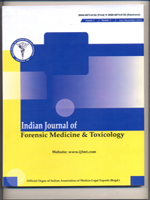Age Dependent Changes in Lobules of Human Ear&its Influence on Individual Identification
Subscribe/Renew Journal
A morphometery of 160 ear lobules of 80 individuals of age ranging from 1-20 years was done to work out growth related change in northwest Indian population. The study was aimed to obtain average values and range of measurements of several parameters of ear lobule and the difference between right and left lobules in growing age groups. Various measurements of lobule were taken with measuring tape and vernier calipers. Various age group divided into four categories as A, B, C and D representing population of 1- 5 years, 6-10 years, 11-15 years and 16-20 years respectively.40 ears of 20 subjects from each of the age category were chosen. Only male subjects were taken. The female subjects were excluded due to ear piercing. The results of measurements like length, breadth and thickness were tabulated and analyzed using ttest. All the measurement showed increasing order trend in increasing age groups. The growth pattern of length of ear lobules shows significance change from group A to B and from group C to D on both right and left side. The Breadth and thickness show almost similar pattern in increase in growth in all the age groups on both right and left side. Our measurements of ear lobule length showed lesser value as compared to Caucasian and Japanese populations. The square type of ear lobule was seen in all the subjects except one. The study among onge tribe of Andhra (India) and newas of Nepal also determined square type as predominant type of ear lobule in the region. The shape of ear lobule was found to be bilaterally symmetrical in all cases.
Keywords
Ear Lobule,pinna, Morphometry of Ear Lobule, Square Ear Lobule, Pendulous Ear Lobule.
Subscription
Login to verify subscription
User
Font Size
Information



